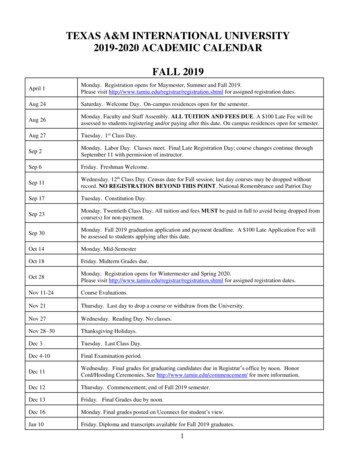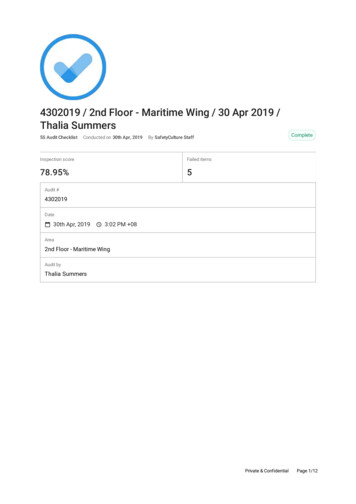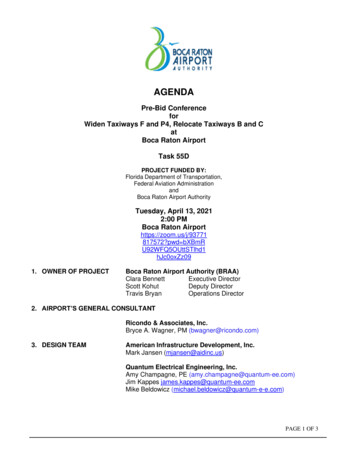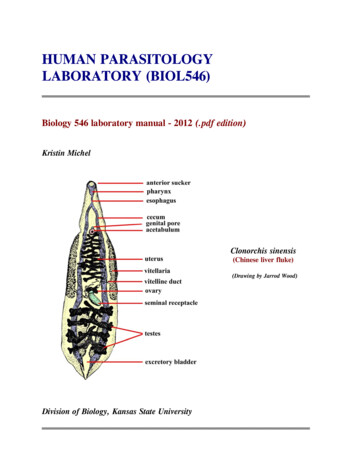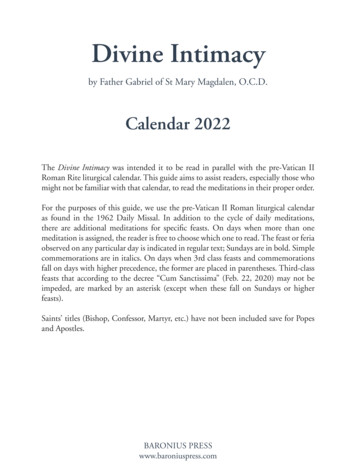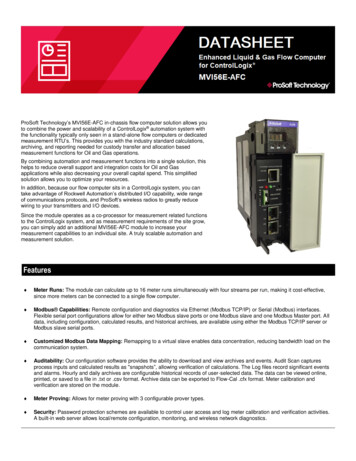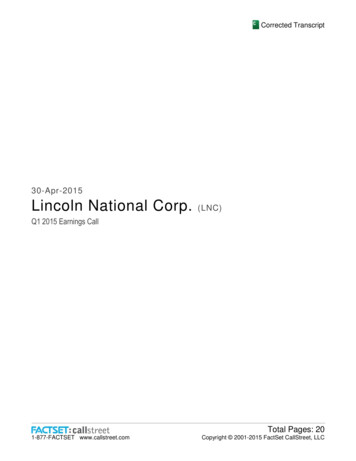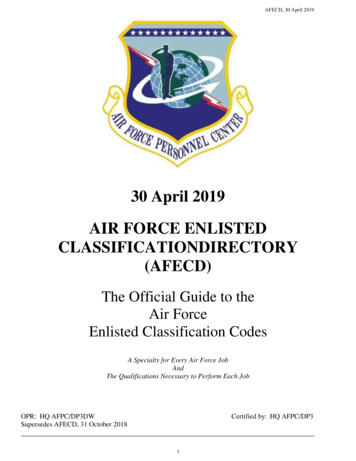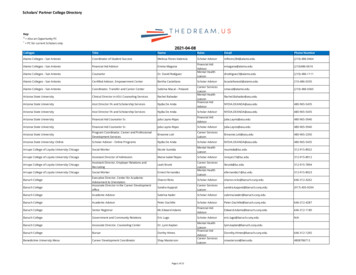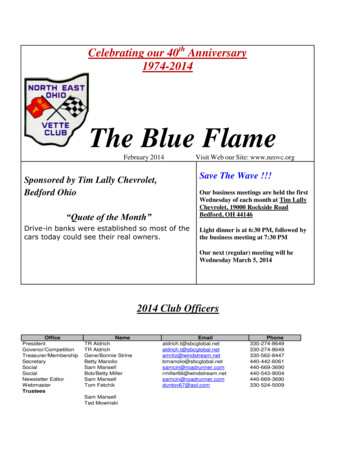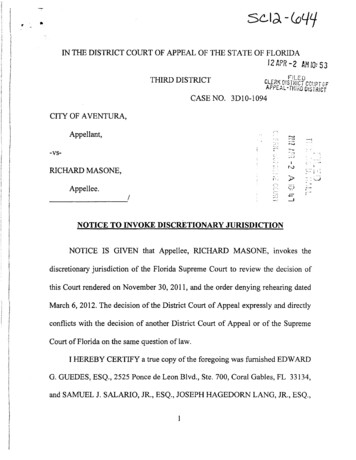
Transcription
IN THE DISTRICT COURT OF APPEAL OF THE STATE OF FLORIDA12 APR - 2 AM 10: 53THIRD DISTRICT.FILt:DCL.I? [I!SjRI P COURT GFAt'PEAL·, Hh O DIS H lCTCASE NO. 3D10-1094CITY OF A VENTURA,.Appellant,,,,-'-- .--vs ', "'-'. ";:)- - l."-C-:RICHARD MASONE,.'Itv, Appellee.r: ,J 1,--':' }-1 --' ; '--'--JNOTICE TO INVOKE DISCRETIONARY JURISDICTIONNOTICE IS GIVEN that Appellee, RICHARD MASONE, invokes thediscretionary jurisdiction of the Florida Supreme Court to review the decision ofthis Court rendered on November 30, 2011, and the order denying rehearing datedMarch 6, 2012. The decision of the District Court of Appeal expressly and directlyconflicts with the decision of another District Court of Appeal or of the SupremeCourt of Florida on the same question of law.I HEREBY CERTIFY a true copy of the foregoing was fumishedEDWARDG. GUEDES, ESQ., 2525 Ponce de Leon Blvd., Ste. 700, Coral Gables, FL 33134,and SAMUEL J. SALARIO, JR., ESQ., JOSEPH HAGEDORN LANG, JR., ESQ.,1
.AMANDA ARNOLD SANSOME, ESQ., 4221 W. Boy Scout Blvd., Ste. 1000,Tampa, FL 33607, by mail, on March 30, 2012.Bret Lusskin, Esq.THE TICKET CRICKET1001N. Federal Highway, Ste. 106Hallandale, FL 33009andBURLINGTON & ROCKENBACH, P.A.Courthouse Commons/Suite 430444 West Railroad AvenueWest Palm Beach, FL 33401(561) 721-0400(561) 721-04 (faxo eys forBy: BAROD. ROCKENBACHteLaw.comFlorida Bar No. 10061aah@FLAppellateLaw.com2
.,. .-:·-7,.'. -··.:'··-'-·--.-.---- . , . -", --.----.' . , , - - - - - - -. . ,'.'l[btrb 7Bt trttt ourt of pptalState of Florida, July Term, A.D. 2011Opinion filed November 30,2011.Not final until disposition of timely filed motion for rehearing.No.3DlO-1094Lower Tribunal No. 09-12736City of Aventura, Florida,Appellant,VS.Richard Masone,Appellee.An Appeal from the Circuit Court for Miami-Dade County, Jerald Bagley,Judge.Weiss Serota Helfman Pastoriza Cole & Boniske and Edward G. Guedesand Michael S Popok, for appellant.Bret Lusskin (Hallandale); Burlington & Rockenbach and Bard D.Rockenbach and Andrew A. Harris, for appellee.Carlton Fields and Samuel J. Salario, Jr., and Joseph Hagedorn Lang, Jr , andAmanda Arnold Sansone, as Amicus Curiae.Before CORTINAS and ROTI:1ENBERG,l JJ., and SCHWARTZ, Senior Judge.1 JudgeIIRothenberg did not hear oral argument, but participated in the decision.
,w; ,:,,.-; . . ---.--.' . . ,' -. . . . . . .1. . . . . . . . . . . . . . . CORTINAS, J.The City ofAventura (the "City") seeks review of the trial court's ruling thatsection 48-26 of the City's Code of Ordinances, allowing the use of image capturetechnologies for monitoring and enforcing laws relating to traffic control signals, isinvalid and unenforceable. We reverse.The City is a municipal corporation organized and existing under the laws ofthe State of Florida, and located in Miami-Dade County, Florida. On October 18,2007, the City enacted Ordinance 2007-5, inclusive of section 48-26, which inpertinent part, authorized the City to use a monitoring system consisting ofcameras at traffic lights to capture and record images of drivers who fail to stop atred lights (''red light infraction"), and issue notices of violation for such red lightinfractions after the images are reviewed for accuracy by a traffic control reviewofficer appointed by the City. See A ventura, Fla., City Code, ch. 48, art. 3 & ch. 2,art. 5, § 2-348(b) (2007).After allegedly failing to stop at an intersection monitored by automatedcameras, Richard Masone ("Masone") was issued two (2) violation notices onJanuary 9,2009, and January 12,2009, respectively. Masone filed a complaint fordeclaratory relief, contending that the two violation notices were invalid exercisesof municipal authority, and seeking that 1) the Ordinance be declared invalid, 2)the Ordinance be declared invalid to the extent it applies to red light violations, and2
----- . . ," ":1 '""--.'-.". -. . 'I.3) that any municipal traffic citations issued under the Ordinance be declared to beof no legal effect? Specifically, Masone argued that, in enacting the Ordinance,the City has legislated on a subject reserved exclusively for the Florida Legislatureand, as such, the Ordinance is invalid because it is preempted by, and directlyconflicts with, Florida law. In defending the Ordinance, the City asserted that, byadopting Chapter 316, Florida Statutes, the Legislature expressly authorizedmunicipalities to supplement existing statewide traffic control laws by grantinglocal municipal governments the right to regulate traffic on roadways throughouttheir respective boundaries through security devices such as the red light camerasystem adopted in the Ordinance.Further, the City argued that any penaltiesimposed were deemed non-criminal, non-moving violations for which a civilpenalty was assessed, as authorized by the Florida Legislature for code infractions.Ultimately, the trial court granted Masone's motion for summary judgment,reasoning that section 48-26 was an invalid exercise of municipal power withoutexpress authority from the Florida Legislature allowing the City to legislate thesubject.Specifically, the trial court stated that "the problem exists with theprovision of Section 48-26 which allows such cameras to be used as the sole basisfor issuing citations against drivers who disobey an official traffic device. . . .Masone argues that he filed a declaratory action because he had no adequateremedy at law and the sole defensive option provided under the Ordinance is ahearing before a special master, who does not have authority to makepronouncements regarding the validity of municipal ordinances under state law.23
I "----"-"-. .III. "Il!:" . " . "Section 316.640(5)(a), Florida Statutes, requires that citations be issued when anjofficer 'observes the commission of a traffic infraction.'"Based upon thesereasons, the trial cowt concluded that section 48-26 is in direct conflict withsection 316.007, Florida Statutes. We disagree.It is well established that Florida law grants municipalities broad home ruleand police powers The Florida Constitution provides for such municipal powers,by stating that. Municipalities shall have governmental, corporate and propriety powers toenable them to conduct municipal government, perform municipal functions,and render municipal services, and may exercise any power for municipalpurposes except as otherwise provided by law.Art. VITI, § 2(b), Fla. Const. This principle of broad municipal home rule powersis codified in chapter 166, Florida Statutes. For example, section 166.021(3)(c),Florida Statutes states:The Legislature recognizes that pursuant to the grant of power set forth in s.2(b), Art. VITI of the State Constitution, the legislative body of eachmunicipality has the power to enact legislation concerning any subjectmatter upon which the state Legislature may act, except:(c) Any subject expressly preempted to the state or county goverrunent bythe constitution or by general law .§ 166.021(3)(c), Fla. Stat. (2008). The plain language therefore grants a municipalgovernment the authority, under broad home rule powers, to enact localordinances, which are not inconsistent with general law.4
"1r.! . .,.,."., . . .-- ---.,.------.p . -- ---- . .In furtherance of a municipal government's broad home rule powers, "[a]regularly enacted ordinance will be presumed to be valid until the contrary isshown, and a party who seeks to overthrow such an ordinance has the burden ofestablishing its invalidity." Lowe v. Broward Cnty., 766 So. 2d 1199, 1203 (Fla.4th DCA 2000) (quoting State ex reI. Office Realty Co. v. Ehinger, 46 So. 2d 601,602 (FJa.l950». Also, it is clear that "[w]here there is no direct conflict betweenthe two, appellate courts should indulge every reasonable presumption in favor ofan ordinance's constitutionality." City of Kissimmee v. Fla. Retail Fed'n Inc., 915So. 2d 205, 209 (citation omitted.); see also Lowe, 755 So. 2d at 1203 ("Anappellate court will 'indulge every reasonable presumption in favor of anordinance's constitutionality."') (quoting City of Pompano Beach v. Capalbo, 455So.2d 468,469 (Fla. 4th DCA 1984».Florida's Uniform Traffic Control Law, embodied in chapter 316, FloridaStatutes, provides for uniform traffic laws throughout the state, counties, and localmunicipalities.§§ 316.001, 316.002, Fla. Stat. (2008).Entitled "Provisionsuniform throughout state," section 316.007, Florida Statues, provides, in pertinentpart, that[t]he provisions of this chapter shall be applicable and unifonn throughoutthis state and in all political subdivisions and municipalities therein, and nolocal authority shall enact or enforce any ordinance on a matter covered bythis chapter unless expressly authorized.5
. , . .§ 316.007, Fla. Stat. (2008). Notably, however, the Uniform Traffic Control Lawalso expressly recognizes the power of municipalities to pass traffic ordinances forthe regulation of municipal traffic in their respective jurisdictions. § 316.002, Fla.Stat. (2008). Enumerating certain "powers of local authorities," section 316.008,Florida Statutes, specifies that:(1) The provisions of this chapter shall not be deemed to prevent localauthorities, with respect to streets and highways under their jurisdiction andwithin the reasonable exercise of the police power, from:(a) Regulating or prohibiting stopping, standing, or parking.(b) RegUlating traffic by means of police officers or official traffic controldevices.(w) Regulating, restricting, or monitoring traffic by security devices orpersonnel on public streets and highways, whether by public or privateparties and providing for the construction and maintenance of such streetsand highways.§ 316.008, Fla Stat. (2008).Thus, the plain text of the Uniform Trafl:ic Control Law expressly confersauthority to a municipal government to regulate traffic within its municipalboundaries as a reasonable exercise of its police power where such regulation doesnot conflict, but supplements the laws found therein.See §§ 316.002,316.008(1)(w), Fla. Stat. (2008). Here, the Ordinance was enacted by the City,under its broad home rule powers in response to concerns that drivers at dangerous6
- - ."11-':- ;;.: '-::.' . ------ . ----- - .- . .- .'. .rw::", . : . ': . " . intersections within the municipal boundaries were failing to heed existing trafficcontrol signals, resulting in a high incidence of serious, life-threatening accidents.As set forth in section 316.002, "[t]he Legislature recognizes that there areconditions which require municipalities to pass certain other traffic ordinances inregulation of municipal traffic that are not required to regulate the movement oftraffic outside of such municipalities." § 316.002, Fla. Stat. While chapter 316creates traffic laws which are applicable throughout the entire state, municipalitieshave the power to pass certain ordinances that regulate municipal traffic withintheir borders. The City is in a unique position to identifY dangerous intersectionswithin in its boundaries and implement additional safeguards to prevent accidentsat such intersections.Accordingly, the City's enactment of the Ordinance toregulate traffic through the use of cameras was a proper exercise of the grantedauthority to regulate, control, and monitor traffic movement. 3The trial court found that the Ordinance conflicts with the Uniform TrafficControl Law. In order for this Court to find that there is conflict between theUniform Traffic Control Law, and the Ordinance, both "must contradict each otherin the sense that both the legislative provisions (the ordinance and the statute)cannot co-exist" F.Y.I. Adventures, Inc. v. City of Ocal 698 So. 2d 583, 584The Ordinance specifically states: "This section shall not supersede, infringe,curtail or impinge upon state or county laws related to red light signal violations orconflict with such laws/'31
,.- (Fla. 5th DCA 1997). In other words, "[t]hey are in 'conflict' if, in order tocomply with one, a violation of the other is required." Id. Because municipalitiesenjoy broad home rule powers, the regulation of vehicular traffic is a well estabLished legitimate exercise of municipal police power. See City of Miami v.Aronovitz, 114 So. 2d 784, 788 (Fla. 1959) ("Giving recognition to our establishedjudicial viewpoint that an automobile is a dangerous instrumentality, we mustconcluded [sic] that any procedure lawfully directed toward the effectiveprevention of the negligent operation of the automobile and the imposition ofrequirements of competency on the part of the driver thereof, should meet withjudicial approbation.").Here, the Ordinance is .consistent, and does not conflict, with any provisionfound within the Uniform Traffic Control Law as mandated by section 316.007,Florida Statutes. Local authorities are explicitly granted the right to enact laws orordinances within their home rule power, supplemental to existing state laws, toregulate, control, and monitor traffic movement. Because there is no provision inthe Uniform Traffic Control Law that expressly preempts or conflicts with theOrdinance necessary to overcome the City's exercise of its broad home rulepowers, we find the Ordinance valid under Florida Law.The trial court found that the Ordinance was in conflict with section316.640(5)(a), Florida Statutes, in so far as the subsection "requires that citations8
. . . ,"1'S'1 :. ".",":. . -;. -, .- .-. . . -.,.be issued when an officer 'observes the commission of a traffic infraction.'"However, upon complete review, we fmd that section 316.640(5)(a), FloridaStatutes, is applicable only to "traffic infraction enforcement officers" as employedby a municipaHty to issue citations for traffic or parking infractions under theUniform Traffic Control Law. In whole, the subsection provides:(5)(a) Any sheriffs department or police department of amunicipality may employ, as a traffic infractionenforcement officer, any individual who successfullycompletes instruction in traffic enforcement proceduresand court presentation through the Selective TrafficEnforcement Program as approved by the Division ofCriminal Justice Standards and Training of theDepartment of Law Enforcement, or through a similarprogram, but who does not necessarily otherwise meetthe uniform minimum standards established by theCriminal Justice Standards and Training Commission forlaw enforcement officers or auxiliary law enforcementofficers under s. 943.13. Any such traffic jnfractionenforcement officer who observes the commission of atraffic infraction or, in the case of a parking infraction,who observes an illegally parked vehicle may issue atraffic citation for the infraction when, based uponpersonal investigation, he or she has reasonable andprobable grounds to believe that an offense has beencommitted which constitutes a noncriminal trafficinfraction as defined in s. 318.14.§ 316.640(5)(a), Fla. Stat. (2008). The plain language mandates that a trafficinfraction enforcement officer may issue a traffic citation after the observation ofthe commission of either a traffic or parking infraction for which he or she hasreasonable and probable grounds to believe that a noncriminal traffic infraction9
. " . " 0 - . - - ' · '. . .was committed under section 318.14, Florida Statutes. Thus, the subsection islimited in scope to specific traffic infraction enforcement officers operating solelyunder the Uniform Traffic Control Law.In contrast, the Ordinance allows for a traffic control infraction reviewofficer, who although sharing the qualifications of the type of officer referenced insection 316.640(5)(a), is instead appointed by the City pursuant to the Ordinanceand for the distinct purposes of viewing recorded images and issuingcorresponding citations in accordance with the Ordinance.Essentially, theOrdinance supplements law enforcement personnel in the enforcement of red lightinfractions, by issuing a notice of violation under the City's Code of Ordinances,deemed a non-criminal, non-moving violation, for which a civil penalty shall beassessed. The Ordinance does not prohibit law enforcement officers from issuing acitation in accordance with the Uniform Traffic Control Law, nor does it"supersede, infringe, curtail or impinge upon state or county laws related to redlight signal violations." Aventura, Fla., City Code, ch. 48, art. 3 § 48-26 (2007).Rather, the Ordinance's utilization of image capture technologies is meant to serveas an ancillary deterrent to red light infractions. Id.Furthennore, while section 48-26 allows the City to utilize cameras underthe Ordinance, all alleged red light infractions are recorded and reviewed by aTraffic Control Infraction Review Officer) who verifies the accuracy of the10
,.::- ,"".",'.,".''.: .'recording before issuing a notice ofviolation. 4 See Aventura, Fla., City Code, ch.48, art. 3 §§ 48-26,48-27,48-29,48-31. The Ordinance mandates that the TrafficControl Infraction Review Officer review and verify the recorded images prior tothe issuance of a notice of violation which parallels the requirement that a trafficinfraction enforcement officer under the Uniform Traffic Control Law observe thetraffic violation and, does not conflict with the requirements of subsection316.640(5)(a), Florida Statutes. Accordingly, we fmd the trial court erred in itsdetermination that section 48-26 allowed the cameras to serve as the sole basis forissuing a notice of violation in direct conflict with section 316.007, FloridaStatutes.Contrary to our dissenting colleague's assertions, the Ordinance is also notpreempted, either expressly or impliedly, by state law. The dissent points to thelanguage of sections 316.002 and 316.007 as being demonstrative of statepreemption.More specifically, the dissent highlights the language in section316.002, which makes it "unlawful for a local authority to pass or to attempt toenforce any ordinance in conflict with the provisions of this chapter."Section316.007 provides:More specifically, "[t]he City's Chief of Police shall designate a Traffic ControlInfraction Review Officer, who shall be a police officer of the City or who shallmeet the qualifications set forth in section 316.640(5)(A), or any other relevantstatute." Aventura, Fla., City Code, ch. 48, art. 3 § 48-31 (B).4iI11
""I'lIt'!""". --.--.," - . . . ----- ., . -----.- . ,.-.""t""C"to".-.The provisions of this chapter shall be applicable anduniform throughout this state and in all politicalsubdivisions and municipalities therein, and no localauthority shall enact or enforce any ordinance on amatter covered by this chapter unless expresslyauthorized. However, this section shall not prevent anylocal authority from enacting an ordinance when suchenactment is necessary to vest jurisdiction of violation ofthis chapter in the local court.§ 316.007, Fla. Stat. (emphasis added).In order "[t]o find a subject matter expressly preempted to the state, theexpress preemption language must be a specific statement; express preemptioncannot be implied or inferred." Hillsborough Cnty. v. Fla. Restaurant Ass'n, 603So. 2d 587,590 (Fla. 2d DCA 1992) (citing Bd. ofTrs. v. Dulje, 452 So. 2d 177(Fla. 2d DCA 1984». Neither the language in section 316.002 nor section 316.007demonstrates express preemption by the state. Determining implied preemptionrequires that the "legislative scheme must be so pervasive that it completelyoccupies the field, thereby requiring a finding that an ordinance which attempts tointrude upon that field is null and void." Id. at 591 (citing Tribune Co. v. Cannella,458 So. 2d 1075, 1077 (Fla. 1984»; see also Phantom of Clearwater, Inc. v.Pinellas Cnty., 894 So. 2d 1011, 1019) (Fla. 2d DCA 2005) ("[C]ourts implypreemption only when 'the legislative scheme is so pervasive as to evidence anintent to preempt the particular area, and where strong public policy reasons existfor finding such an area to be preempted by the Legislature."') (quoting12
. - . .,.:." .,w·' .'"-'--.,. .-. ----. -. ----.-.-- . -. Tallahassee Mem'l Reg'l Med. Ctr., Inc. v. Tallahassee Med. Ctr., Inc., 681 So. 2d826, 831 (Fla. 1st DCA 1996». Chapter 316 cannot be classified as being "sopervasive that it completely occupies the field." On the contrary, section 316.008specifies that no provision of chapter 316 prevents local authorities, within thereasonable exercise of their police power from "[r]egulating, restricting, ormonitoring traffic by security devices." § 316.008(1)(w), Fla. Stat.precisely what the City has done.This isThe City, via image capture technologies,monitors intersections it has determined to be of particular concern for trafficaccidents, and regulates and restricts red light infractions at those intersectionsthrough the issuance of its notices of violation. Doing so is well within the City'sexercise of its broad home rule power and falls squarely within the specificauthority carved out in section 316.008( 1)(w) by the Florida legislature.Moreover, a complete examination of the exceptions carved out undersection 316.008 demonstrates that local authorities, such as the City, in accordancewith their home rule powers are not prevented from(h)Regulating the operation of bicycles.(i) Regulating or prohibiting the turning of vehicles orspecified types of vehicles.(r) Regulating pedestrian crossings at unmarkedcrosswalks.13
". . ,'''E:'' r" . . .(8) Regulating persons upon skates, coasters, and othertoy vehicles.§ 316.008 (l)(h)-(i), (r)-(s). A local authority can accomplish these regulationsthrough duly enacted ordinances such as the one at issue. Section 316.008 allowsthe local authorities to use their home rule powers to effectuate certain restrictionsand regulations but does not specify the means or the schemes for implementingsuch restrictions or regulations.' Through the Ordinance, the City has simply'developed a procedure for carrying out its power to regulate, restrict or monitortraffic.The dissent also states that when a notice of violation is contested, "a quasijudicial adjudication on the merits is made by a procedure established by the Cityin violation of article V of the Florida Constitution and chapters 316 and 318 of the,Florida Statutes." It is undisputed that the City has broad home rule powers as setforth in section 166.021, Florida Statutes and Article VIII, section 2(b) of theFlorida Constitution.Consistent with these broad powers, the City's Codeprovides for the appointment of Special Masters and further provides that a personserved with a notice of a violation of the City's Code may request anadministrative hearing for purposes of appeal. See Aventura, Fla., City Code, ch.2, art. V §§ 2-334,2-335,2-341. The City is not creating a new "court" to addressred light infractions under its Code, but is instead simply utilizing an already14
I"'!2 . : .'. . .--- . . . . . . .1Ijexisting mechanism, consistent with its home rule powers, to resolve issues arisingfrom notices of code violations. The Ordinance specifies thatNotices of infractions issued pursuant to this article shallbe addressed using the [C]ity's own Special Masterspursuant to Article V, Chapter 2 of the City Code and notthrough uniform traffic citations or county courts. Thisshall not bar the use of uniform traffic citations and thecountry courts when city police personnel decide not torely on this article as the enforcement mechanism for aspecific violation.Aventura, Fla, City Code, ch. 48, art. 3 § 48-26 (2007). Contrary to the dissent'sassertion, even though the matter is initially appealed before a Special Master,"[a]n aggrieved party, including the City, may appeal a final order of a SpecialMaster to the circuit court." Aventura, Fla., City Code, ch. 2, art. V § 2-345.Florida courts routinely address cases involving appeals to the circuit court fromthe decisions of special masters or hearing officers as to local government codeviolations, and, in doing so, recognize the use of such administrative mechanismsfor the resolution of code .violations. See Hardin v. Monroe enty., 64 So. 3d 707,709-10 (Fla. 3d DCA 2011); City of Palm Bay v. Palm Bay Greens, LLC, 969 So.2d 1187 (Fla. 5th DCA 2007); Miami-Dade Cnty. v. Brown, 814 So. 2d 518 (Fla.3d DCA 2002).We find no distinction between the administrative resolutionmechanisms in such cases and in the City utilizing a Special Master, under thefacts of this case, to resolve initial disputes of notices of violation. We, therefore,15'"!'W4.
· . --1l11!"". . ,."'fE"" find no conflict between state law and the procedure for contesting notices ofviolation set forth in the Ordinance.We also note the Florida Legislature's recent enactment of the "MarkWandall Traffic Safety Act" (the "Act") within the Unifonn Traffic Control Law.Laws of Fla., ch. 2010-80, §§ 6 & 7 (2010). The Act implements a statewide redlight signal enforcement scheme regulating the use of any traffic infraction detectoron state, county, and local municipal roads. The plain language makes clear theLegislature is aware of municipal programs like the Ordinance, and in turn, hascreated a statutory scheme for statewide regulation which in no way invalidatessuch existing programs. 5Importantly, the Act does not invalidate existingmunicipal traffic monitoring systems, such as red light cameras, but now expresslyregulates any such programs and thus, now expressly preempts municipalFor example, section 316.07456, Florida Statutes, provides that any trafficinfraction detector5[a]cquired by purchase, lease, or other arrangement entered into by acounty or municipality on or before July 1, 20 II, or equipment usedto enforce an ordinance enacted by a county or municipality on orbefore July 1, 2011, is not required to need the specificationsestablished by the Department of Transportation until July 1,2011.Laws of Fla., ch. 2010-80, § 7 (2010).16
·-. .' 1Ir. .:.--. -.-rr . . -. . ., . regulation under the Uniform Traffic Control Law to conform to adoptedspecifications of the Department of Transportation. rd. 6Based upon the foregoing, we find the trial court erred in detenniningsection 48-26 of the Ordinance invalid and unenforceable and, accordingly, wereverse.IReversed and remanded.JjSCHWARTZ, Senior Judge, concurs.6 Althoughthe City has since amended the Ordinance to comply with the languageof the Act, the amendment of the Ordinance does not affect our decision and ourholding is limited to those cases involving notices of violation issued prior to theamendment of the Ordinance.17
I.City of Aventura, Florida v. Richard MasoneCase No. 3DIO-I094ROTHENBERG, J. (dissenting).The trial court concluded that section 48-26 of the City of Aventura's Codeof Ordinances, the photo enforcement red light violation ordinance, is preemptedby and in conflict with Florida law, and is, therefore, invalid. Because I agree withthe trial court, I respectfully dissent from the majority opinion concludingotherwise.Due to the inconsistency of penalties imposed by the municipal courts andthe inconsistency of traffic laws in municipalities around the state, article V,section 20(d)(4) of the Florida Constitution was enacted to abolish all of themunicipal courts, and the Florida Legislature created chapter 316 to provide aunifonn statewide traffic control system. Prior to the adoption of article V, therewere sixteen different courts in Florida, which the chairman of the House JudiciaryCommittee characterized as "a hodgepodge of different courts which vary fromcounty to county." Amends. to the Fla R of Appellate Procedure, 696 So. 2d1103, 1111 n.9 (Fla. 1996) (Anstead, J., specially concurring).The chainnanfurther explained that the passage of article V would consolidate the sixteendifferent courts into "four uniform levels of courts: supreme court, district court ofappeal, circuit court and county court."18
Article V, section 1 was enacted to vest the judicial power "in a supremecourt, district courts of appeal, circuit courts and county courts." Further, articleV, section 1, specifies that "[n]o other courts may be established by the state,any political subdivision or municipality." (emphasis added).Chapter 316, Florida's Uniform. Traffic Control Law, took effect on"January 1, 1972 throughout the state and in all municipalities of the state." Ch.71-135, § 6, at 552, Laws of Fla. The Legislature's intent in adopting the FloridaUniform Traffic Control Law was ''to make uniform traffic laws to applythroughout the state and its several counties and uniform traffic ordinances toapply in all municipalities." § 316.002, Fla. Stat. (2008).Section 316.002 also makes it "unlawful for any local authority to pass or toattempt to enforce any ordinance in conflict with the provisions of this chapter."Additionally, section 316.007, Florida Statutes (2008), specifically provides:The provisions of this chapter shall be applicable and uniformthroughout this state and in all political subdivisions andmunicipalities therein, and no local authority shan enact or enforceany ordinance on a matter covered by this chapter unlessexpressly authorized .Despite the proscriptions of sections 316.002 and 316.007, the City ofAventura ("the City") enacted section 48-26 to enforce and punish red lightviolations, a matter already covered by chapter 316, without express authorization19
1r. r············· . . -;". .by the Legislature, and in a manner that is in direct conflict with chapter 316 andFlorida jurisprudence.Further, when a violation is contested, a quasi-judicialadjudication on the merits is made by a procedure established by the City, inviolation of article V of the Florida Constitution and chapters 3 I 6 an
Apr 02, 2012 · the State of Florida, and located in Miami-Dade County, Florida. On October 18, 2007, the City enacted Ordinance 2007-5, inclusive of section 48-26, which in pertinent part, authorized the City to use a monitoring system consisting of cameras at traffic lights to
